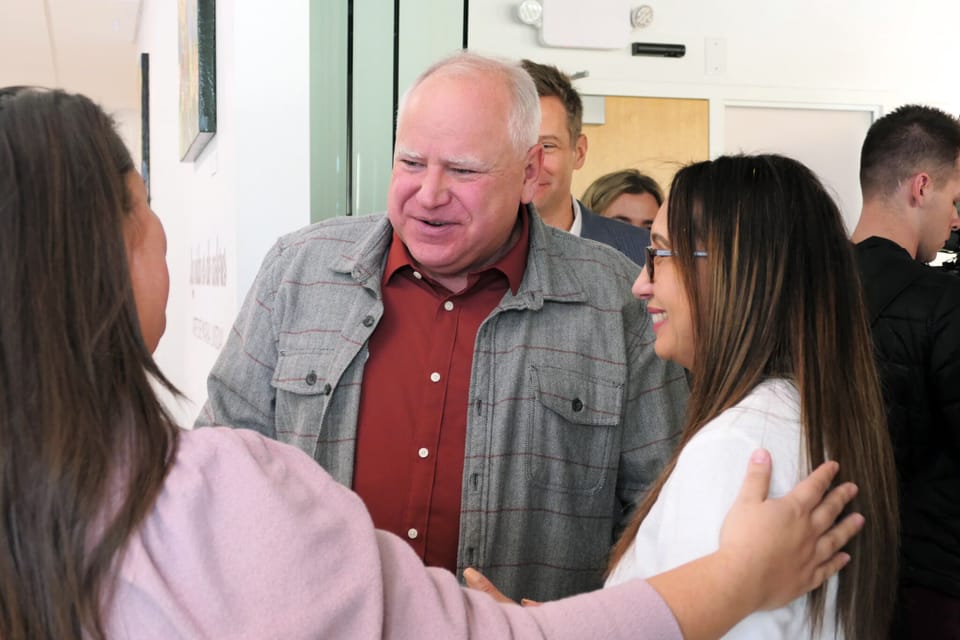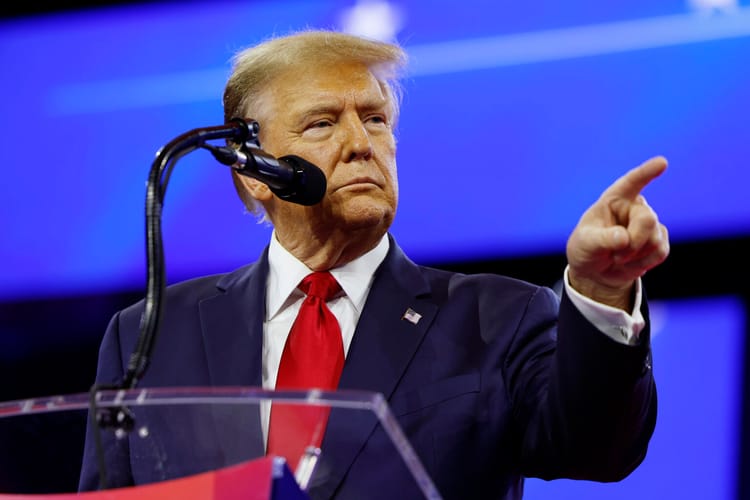Harris names Walz her vice presidential nominee

By J. Patrick Coolican, Minnesota Reformer
Gov. Tim Walz fused his everyman personality with an optimistic progressive message to win the most important audition of his political career the past few weeks, winning the quick admiration of Democratic activists — and Vice President Kamala Harris, who named Walz as her running mate Tuesday.
“As a governor, a coach, a teacher, and a veteran, he’s delivered for working families like his own. We are going to build a great partnership. We start out as underdogs but I believe together, we can win this election,” Harris said in a statement announcing her pick.
Harris’ selection of Walz rockets the former geography teacher from Midwest obscurity into the highest stratosphere of American politics, potentially joining Hubert Humphrey and Walter Mondale as Minnesotan vice presidents.
Walz’s selection follows his splashy arrival on the national stage during a series of high-profile TV interviews since President Joe Biden dropped out of the race last month and threw his weight behind his vice president.
Walz, who tends to talk in a Diet Mountain Dew-fueled, regular guy patois, has impressed Democrats with his ability to communicate the party’s message, while using a one-word zinger — “weird” — to hammer Republicans for book bans and pushing to outlaw abortion nationwide.
The two-term governor, who also served a dozen years in Congress, has racked up an impressive legislative record, especially in his second term. He signed bills to create a paid family and medical leave program; provide for universal free school meals; legalize recreational marijuana; sharply increase tax credits for low-income families; and boost sales and gas taxes for transportation and housing.
“Governor Walz has been a strong leader, a great partner with the Legislature, and is an excellent choice for vice president,” said Minnesota House Speaker Melissa Hortman, DFL-Brooklyn Park. “We worked together over the last two years on the most productive session in Minnesota in decades, passing policies that will help Minnesotans build better lives for themselves and their families.”
Minnesota Republicans say Walz has changed the North Star State for the worse. Minnesota House Minority Leader Lisa Demuth, R-Cold Spring, wrote recently that “past two years featured some of the most extreme and irresponsible policies we’ve ever seen in our state,” citing tax and fee increases, unsustainable new spending, energy mandates that will hike rates and a rise in the cost of Uber and Lyft rides.
Walz brings a resume that suggests both achievement and middle class roots: He was a high school teacher and assistant football coach in the southern Minnesota city of Mankato, population 45,000, before his election to Congress in 2006, becoming the first Democrat to win the 1st Congressional District in more than a decade.
He retired from the National Guard after 24 years in 2005 with the rank of command sergeant major, which made him the highest ranking enlisted man to ever serve in the U.S. Congress. Walz underwent surgery to restore his hearing, damaged after years of exposure to artillery ranges. He recently said he can hunt pheasants better than the GOP vice presidential nominee, U.S. Sen. J.D. Vance.
Expect Walz to post up in the so-called blue wall states of Pennsylvania, Michigan and Wisconsin, where the Harris campaign hopes his middle class demeanor will appeal to white, non-college voters who comprise a strong plurality of those battleground states.
A top Minnesota Democratic-Farmer-Labor operative said Walz is well positioned to help Harris carry those crucial states.
“Tim Walz is a great pick because in addition to his blue collar background and his cultural fit with the blue wall states, as governor his accomplishments are mostly about improving the lives of middle class and working families,” said Jeff Blodgett, who was chief strategist for Sens. Paul Wellstone and Al Franken. “This ticket can now powerfully argue that they are the team that is squarely on the side of America’s working families.”
Walz is married to Gwen Walz, a career educator, and is father to an adult daughter Hope and teenaged son Gus, both born with help of in vitro-fertilization. IVF, which accounts for about 2.5% of all children born in the United States, has become a potent political issue in the past year after the Alabama Supreme Court ruled that embryos created during IVF are legally classified as children; fertility clinics paused use of the technique out of fear of civil and criminal liability.
“It’s not by chance that we named our daughter Hope,” Walz said in response to the IVF controversy.
Walz will use his compelling biography to introduce himself to the American public, but he will also be forced to defend his five-and-a-half-year tenure as governor of the nation’s 22nd most populous state.
First term: managing crisis
Walz’s first term especially was marked by the management of crises, from the COVID-19 pandemic to the aftermath of the police killings of George Floyd and Daunte Wright.
Republicans will almost certainly broadcast images of flaming buildings on Lake Street in Minneapolis, including the 3rd precinct headquarters of the Minneapolis Police Department.
On the second night of protests, as a Lake Street Target was being looted, Minneapolis Mayor Jacob Frey called Walz’s office and requested help from the National Guard, he later told the Star Tribune, which corroborated the account with state and local records.
Walz publicly assumed command Thursday morning, which is when he called up the National Guard. They were on the ground Thursday evening, but still the city burned; MPD evacuated the 3rd precinct headquarters that night, and looters and rioters ransacked it. The fires continued Friday night.
Former Minnesota Senate Majority Leader Paul Gazelka alleged recently that he called the White House, then occupied by former President Donald Trump, and lobbied the administration to push Walz into action.
Walz blamed outsiders for the destruction, a claim that turned out to be mostly false.
Less than a year later, the Twin Cities was on edge at the outset of the trial of former police officer Derek Chauvin, accused of Floyd’s murder. That’s when Brooklyn Center officer Kim Potter killed Daunte Wright, an unarmed Black man, when she drew and fired her service weapon instead of her Taser as she said she intended.
As protests and scattered looting broke out, Walz took a much firmer line, imposing a curfew on three urban counties and bolstering the defense of the Brooklyn Center police headquarters with a massive State Patrol presence.
As during the Floyd protests, journalists and demonstrators were targeted by police, who used tear gas and less-lethal projectiles to subdue crowds. Walz was criticized for the response, including by many progressive Democrats who broke with him.
Even as Walz dealt with the Floyd and Wright police killings and their aftermath, he was also managing the public health crisis of COVID-19. He leaned on Minnesota’s robust public health assets, including the University of Minnesota and the Mayo Clinic. The state’s COVID-19 death rate and overall mortality rate during the pandemic were among the nation’s lowest.
Republicans attacked his COVID-19 restrictions as tyrannical, including a directive to avoid large family gatherings during the holiday season of 2020. They also criticized — and in some cases filed lawsuits over — his restrictions on youth sports, which accompanied long periods of remote schooling.
The administration’s aggressive posture toward the pandemic extended to getting help to people who needed it, including workers suddenly out of work and hungry children. Minnesota was the first state to get unemployment benefits out to gig workers.
Critics say the Walz administration was also blind to a massive fraud happening in plain sight.
Walz’s Department of Education administered a federal program intended to feed hungry children during the pandemic but instead became a cash cow for fraudsters. Legislative audits have sharply criticized the administration’s failure to stop more than $250 million in fraudulent payments in what has become known as the Feeding Our Future fraud; 70 people have been charged and nearly two dozen convicted.
“Under Governor Walz’s watch, fraud and waste in our state public programs has exploded,” Demuth charged.
Second term: Progressive wish list becomes reality
Despite the tumultuous tenure, Walz was easily reelected in 2022 and delivered major coattails: A Democratic trifecta took command of state government in 2023 for the first time in nearly a decade.
Democrats got to work on a wish list which has become the envy of progressives across the country.
Walz pushed for a tax rebate that came in smaller than what he proposed but still amounted to $1,300 for a family of four.
Lawmakers passed a package of $2.6 billion for infrastructure, which has allowed Walz to pose for photos at a bevy of construction projects on roads, bridges and other key infrastructure.
The deal included $300 million for nursing homes, which are newly subject to a labor-friendly sectoral bargaining system.
In one of the Legislature’s first official acts, Minnesota codified abortion rights, becoming a haven in the Upper Midwest even as neighboring states enacted restrictions.
Walz, who was once a fierce gun rights supporter until the 2018 massacre at Parkland High School — which happened as he campaigned for governor — signed two gun control bills in 2023. One extended background checks to all private sales, while a so-called red flag law allows a judge to take a person’s guns if he’s deemed a threat to himself or others.
Walz signed a bill to restore voting rights to people leaving prison. Undocumented people can now get a driver’s license thanks to a bill Walz signed.
A new law mandates a carbon-free electric grid by 2040.
It’s not yet clear what impact these policies will have on the future of Minnesota.
On measures like life expectancy, family income, unemployment, education attainment and violent crime, the Minnesota metrics during Walz’s tenure have mostly risen and fallen alongside national trends, with Minnesota near the top in many of these quality-of-life metrics.
Those measures don’t apply to all Minnesotans, however. The gap between white and Black homeownership in Minnesota is 48 percentage points, for instance. Walz and Democratic lawmakers say that’s precisely why they passed a robust first-time homebuyer assistance program for people with modest incomes.
Walz has said his goal is to make Minnesota the best place in the nation to raise a family, including factors like cost-of-living, housing affordability, good paying jobs, education and child care.
Unfinished business: education
The most troubling metric for Walz, who as a teacher was presumed to be well positioned to be an education governor, is the state’s lackluster performance on student achievement tests in recent years.
Minnesota ranks in the top five best states for children, according to a scorecard compiled by the Anne E. Casey Foundation. But in the same study, Minnesota’s education system dropped to 19th.
Minnesota has long struggled with some of the nation’s worst opportunity gaps, especially for Black and Indigenous students, even as the student population has become steadily more diverse over time.
Walz told the Star Tribune in 2019 that his tenure should be judged by how well he closes the gaps: “It’s a reality I clearly understood and I said during the campaign that I’ll be judged and should be judged by how well we close [those disparities], as long as we’re given the tools, and I take that responsibility,” he said.
Minnesota Reformer is part of States Newsroom, a nonprofit news network supported by grants and a coalition of donors as a 501c(3) public charity. Minnesota Reformer maintains editorial independence. Contact Editor J. Patrick Coolican for questions: info@minnesotareformer.com. Follow Minnesota Reformer on Facebook and X.



Member discussion